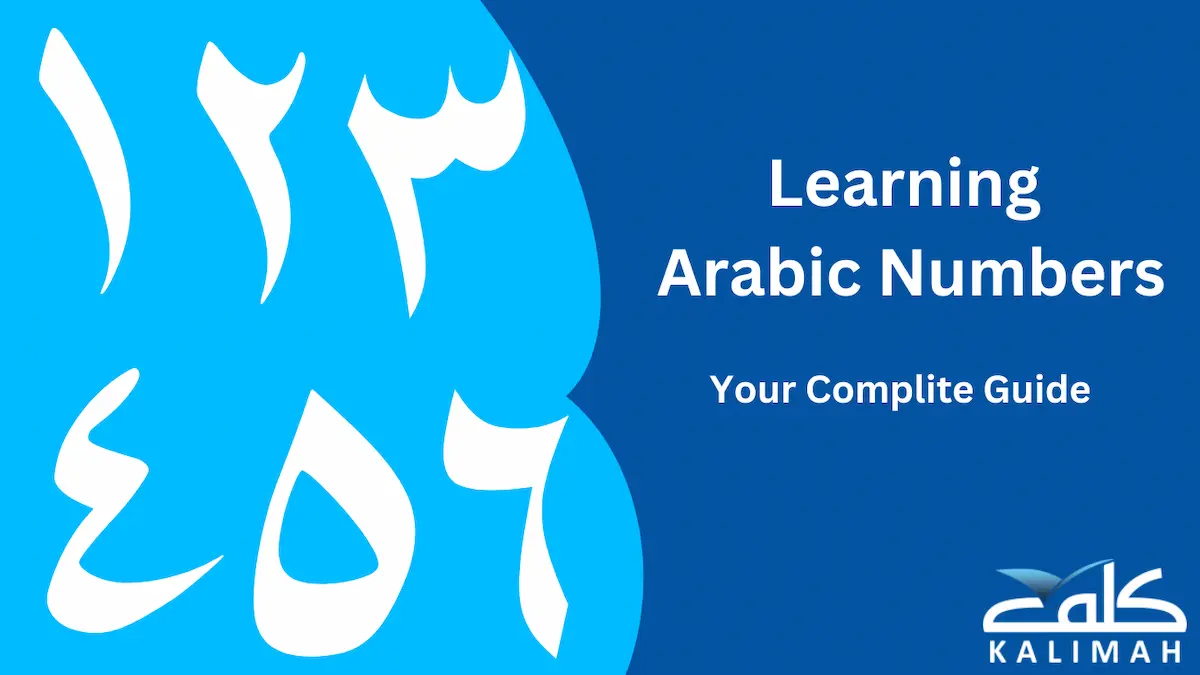Imagine a life without numbers, everything will become unmeasurable, and time, dates, budgets, lengths, sciences, and more will all vanish! That’s why Arab scholars in the 8th century AD got more and more interested in numbers from the beginning of the caliphate’s state growth. It’s time to start learning numbers as you begin your Arabic learning journey! So, what are the basics of Arabic numbers? How can you learn the numbers from 1 to 10?
What Is the Meaning of the Arabic Numbers?
Arabic numbers are a word, a combination of words, or a special pattern that can be applied to describe quantities, dimensions, time, equation variables, code scripts, and more.
History of Arabic Numbers
What makes Arabic numbers special is the history of their development. There are mainly two styles of Arabic numbers, one that most countries use in their daily lives, and the other that is mainly popular in the Middle East and North Africa.
The first is called the Western Arabic numerals, for example, the numbers from 1 to 10 are written this way: 1, 2, 3, 5, 6, 7, 8, 9, 10. Looks familiar, right?
Europeans learned about Western Arabic numerals in the 10th century, mostly from the Arabs of Al-Andalus (Currently Spain and Portugal). This style of Arabic numbers at that time in history was popular among Muslims in North Africa.
While the Eastern Arabic numerals were originally invented by Indian mathematicians, between the 1st and 4th centuries, this makes them older than Western Arabic numbers. If we need to write 1 to 10, they will be written as follows, ١٠, ٨, ٧, ٦, ٥, ٤, ٣ ,٢ ,١.
Al-Khwarizmi is the famous Muslim mathematician who first used these numbers in his writings and helped in spreading this style in the Arab World. in the 9th century. That’s why they’re called Mashriki. Worth mentioning, that Al-Khwarizmi was the first who know how a zero functions, which helped him develop Algebra later.
This means the two styles have the same Indian origin. However, even if they’re written differently, they are written and pronounced in the same way, using the same letters.
read more about how to learn Arabic online
Learn to Count From One to Five
Numbers are like any Arabic word, if you know the pronunciation and phonetics, they will be easily spoken, written, and read.
Here are the numbers from one to five in Modern Standard Arabic:
-
1 One Wahed واحِد
To pronounce this number, divide it into three syllables. The first syllable is pronounced by opening your lips upward and keeping your tongue in your mouth, which forms “Wa”. Following that, slightly close your lips together while exhaling from your deep throat “He”, and finish the word with a “D” sound.
-
2 Two Ithnan اثْنَان
This number can be broken down into two syllables, with the first syllable being pronounced as “Ithn” and the second syllable, “Nan,” acting as a link.
-
3 Three Thalatha ثَلَاثَة
Three syllables make up the number; the first is “Tha,” the second is “La,” and the third is “Tha.” So, the final form is “Tha-La-Tha”.
-
4 Four Arba’a أَرْبَعَة
This number is a challenge for most learners. It has two syllables, one of which containing the letter “Ain ع”. The first syllable is “Ar”, the second is “Ba”, and the third is “ ‘aa”. During pronouncing the third syllable, the epiglottis goes towards the back wall of the throat to make the right sound.
-
5 Five Khamsa خَمْسَة
Another difficult number because it contains the letter “Kha’” which causes the back of the tongue to rise when spoken. The number “Kham-Sa” is primarily made up of the two syllables “Kham” and “Sa”.
From Six to Ten
The next five numbers should be learned after you have mastered the first five. According to MSA, the numbers 6 through 10 will be written and pronounced as follows:
-
6 Six Setta سِتَّة
The two syllables in this number are “Set” and “Ta”. It is a fairly easy and fluid number.
-
7 Seven Sab’a سَبْعَة
Due to the existence of the letter “Ein,” the two-syllable number seven, “Sab-‘aa” is just as challenging as Arba’a. so , you need to imitate the third syllable you’ve produced when pronouncing Arba’a “4” to correctly pronounce the second syllable here.
-
8 Eight Thamanyia ثَمَانِيَة
The number eight in Arabic consists of three syllables. Each syllable has a vowel, as we call it in English. The syllables are “Tha”, “Ma”, and “Nyia”.
-
9 Nine Tes’ah تِسعْة
Like the number seven, similarly. Here, the Arabic word for nine has two syllables: “Tes” and “‘ah.” Apply the same method and point of articulation that you did when pronouncing Tes’ah and Arba’a.
-
10 Ten ‘ashrah عَشْرَة
The Arabic number ten consists of two syllables; “‘Ash” and “Rah”. This number contains the “Ein” at the first syllable, not the second or the third syllables as previous numbers.
Learn the Zero صِفُر
It’s a two-syllable number “Say-fur”, which is the zero that gives value to any whole number when it is on the right side of the number, but is worthless when it is on the left side. Although Al-Khwarizmi later developed its functions, the digit was originally an Indian digit. A zero can be found in many places, including phone numbers, credit cards, some Arab countries’ ground floor, etc.
During the Crusades against Jerusalem, Egypt, and the Levant, Europe became familiar with the Arabic zero.
What are Arabic Numerals?
Hindu Arabic is frequently used in state-run institutions, official documents, etc. in many Arab nations. They are so named because, as we previously stated, they are of Indian ancestry. Typically, they consist of 10 digits, which can be combined to create any number you need to write down or formulate. The same direction of flow is used to write these numbers, from left to right, as it is to write Western Arabic numbers 1, 2, 3, etc.
FAQs
Why Are Arabic Numerals Base 10?
Arabic numerals are based on the fact that most people have ten fingers, which they can use for simple counting.
How Do You Say 100 in Arabic?
The number 100 is pronounced in Arabic as “Me’ah مئة”. It consists of two syllables “Me’’’ and “Ah”. Some wrongly pronounce “Ma’ah مائة” which totally wrong. It is only correct when it is a conjugate to multiple of hundred like “ThalathMa’ah ثلاثمائة”.
How to Memorize Arabic Numbers?
Memorizing Arabic numbers depends on knowing the forms of Western and Eastern Arabic. Here is an App that helps you write the number shapes correctly.
Also, memorizing need to practice writing the numbers in letters and pronouncing them, there is another app that helps you achieve these missions:
After that, try to apply what you learn in your daily life to make it natural, and transfer the knowledge from short-term memory to long-term memory.
Why Are English Numbers Called Arabic?
English Numbers are Called Arabic because Europe borrowed the Western Arabic numbers during the Arab existence in the Iberian Peninsula in the 10th century.
What Does 7 Mean in Arabic Texting?
Sab’a سَبْعَة means 7 in Arabic texting. It is written like this ٧ in the Eastern Arabic form.
Which Countries Use Arabic Numerals?
Egypt, Sudan, Asian Arab countries, GCC, Iran, and Afghanistan all use Arabic Numerals.
What Is the Difference Between Arabic and Roman Numerals?
Roman Numerals don’t include a zero. That’s a significant difference between Arabic and Roman numerals. The numbers were written in this way:
| Thousands | Hundreds | Tens | Units | |
| 1 | M | C | X | I |
| 2 | MM | CC | XX | II |
| 3 | MMM | CCC | XXX | III |
| 4 | CD | XL | IV | |
| 5 | D | L | V | |
| 6 | DC | LX | VI | |
| 7 | DCC | LXX | VII | |
| 8 | DCCC | LXXX | VIII | |
| 9 | CM | XC | IX |
Learning Arabic numbers is an important first step that makes it easier to comprehend the many contexts in which numbers are used. You can ask for prices, weights, lengths, distances, times, and more by using numbers. Everywhere in the world, including the Arab countries, numbers play a significant role in daily life. For this reason, you should learn them.
🌟 Unlock Your Potential in Arabic and Quran with Kalimah Center! 🌟
Ready to deepen your connection with the Quran and enhance your understanding of Arabic? Join Kalimah Center today and embark on a transformative journey of learning and growth! Our professional, handpicked Online Arabic and Quran Tutors are dedicated to helping you master these essential skills with ease and expertise.
📚 Explore Our Courses:
Online Arabic Course: Tailored to your level, our comprehensive Arabic program includes 16 teaching levels and 400+ hours of personalized sessions.
Online Quran With Tajweed Course: Perfect for non-Arabic speakers, our course spans 13 levels and equips you with Tajweed mastery from beginner to advanced.
Online Arabic Course For Kids: Nurture your child’s love for Arabic with our engaging and structured program, available in 24 levels for primary, intermediate, and secondary stages.
💡 Why Choose Kalimah?
Expert Tutors: Learn from native Arabic speakers and Ijazah-certified teachers who prioritize your progress.
Flexible Learning: Enjoy one-on-one classes, 24/7 access to materials, and interactive exercises for a dynamic learning experience.
Comfortable Environment: Benefit from a supportive and encouraging atmosphere, where mistakes are seen as opportunities for growth.
Proven Success: With over 8,000 students worldwide and glowing testimonials, Kalimah Center is your trusted partner in Arabic and Quran education.
🚀 Start Your Free Trial Today! 🚀
Don’t miss out on this life-changing opportunity to deepen your faith and knowledge. Sign up now for your free trial and take the first step towards becoming a better practicing Muslim with Kalimah Center!














